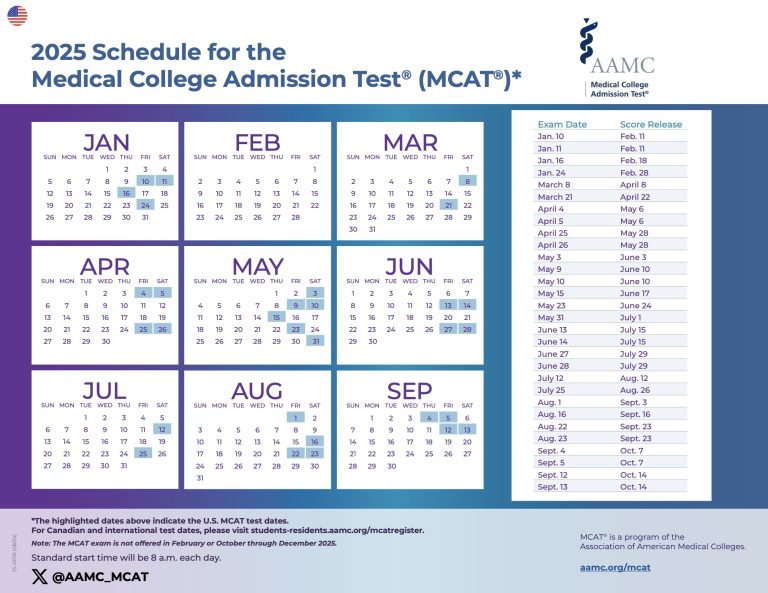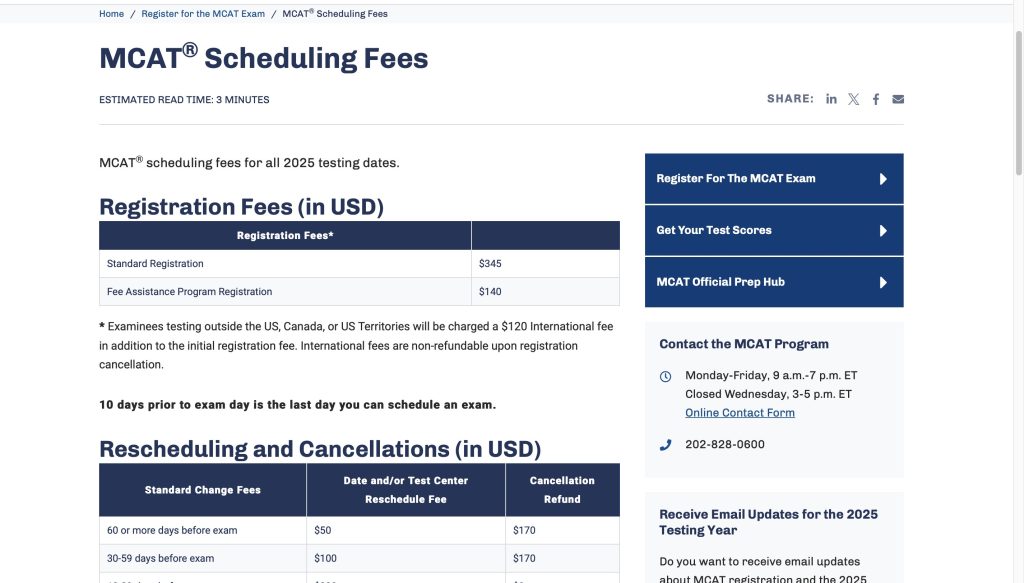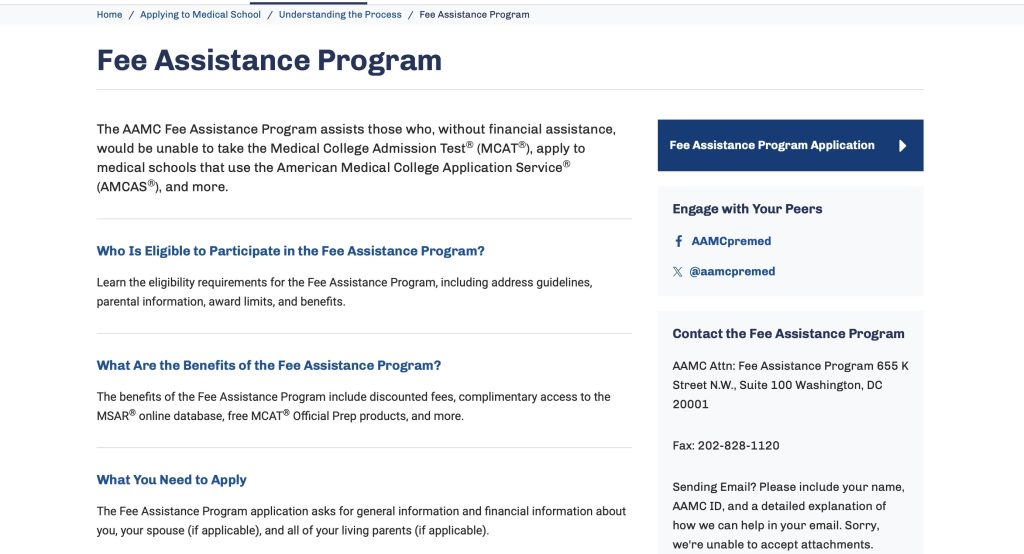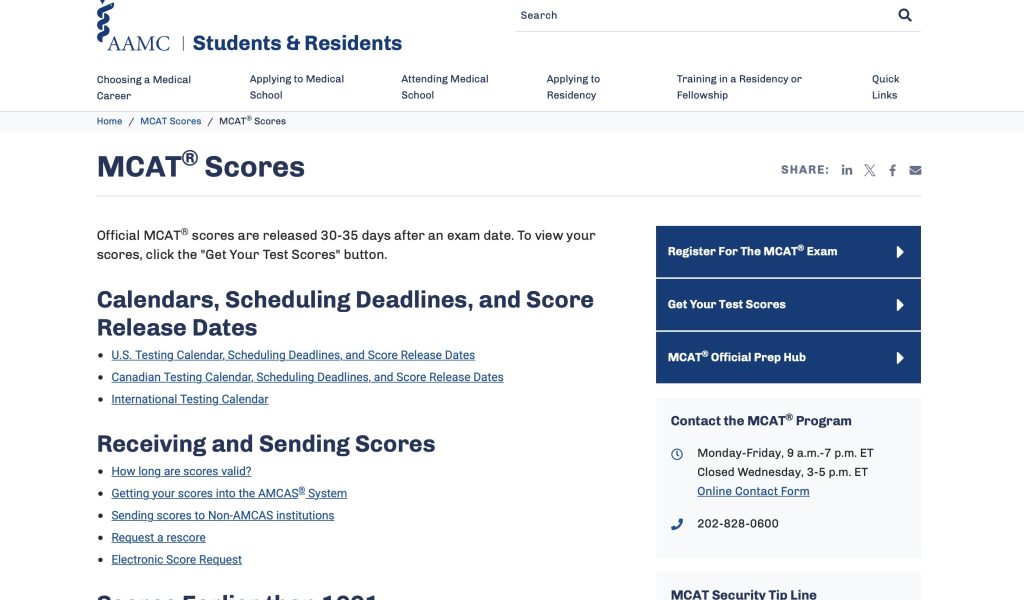MCAT Test Dates and Score Release 2024-2025: Everything You Need to Know
Feeling stressed about the MCAT? You’re not alone. The registration process, finding the perfect test date, securing a spot at the testing center—it’s a lot to juggle on top of your MCAT prep. I’ve been there. I remember how the pressure of registering for the MCAT and selecting a test date sent my anxiety sky-high. But here’s the good news: It doesn’t have to be this overwhelming.
By understanding how the MCAT registration process works, how to choose the best exam date for your schedule, and how the test is administered, you can reduce a lot of that stress and feel more confident as test day approaches. In this guide, I’ll share the official 2024-2025 MCAT test dates and score release schedule, along with some helpful tips on registration and what the test day looks like. I’ll also cover the exam costs and share strategies to help you save money.
MCAT Test Dates and Score Release 2025 Calendar

How Can I Register for the MCAT?
Registering for the MCAT involves a few essential steps. Follow this guide to ensure a smooth registration process:
- Create an AAMC Account: Begin by creating an account on the AAMC (Association of American Medical Colleges) website. Navigate to the “MCAT Registration” section.
- Enter Accurate Demographics: When filling out your demographic information, ensure that it matches exactly with the details on your ID. This is crucial for successful registration.
- Score Release Options: You will have the option to allow the AAMC to release your MCAT scores to institutions other than medical schools. Review this option carefully.
- Review MCAT Essentials: Before finalizing your registration, take time to review the MCAT Essentials provided by the AAMC. This document contains important information about the exam.
- Understand Testing Limits: Keep in mind that you have a maximum of seven attempts to take the MCAT throughout your lifetime, with a limit of two attempts per year.
- Check Exam Availability: The MCAT is offered during specific times of the year, typically 2 to 6 times per month over an eight-month period. Given the limited availability, it’s essential to register as early as possible to secure your preferred date and location.
By following these steps and registering promptly, you can maximize your chances of obtaining a suitable test date and location for the MCAT.


How Can I Pay for the MCAT?
Understanding the costs associated with the MCAT is essential for effective planning. Here’s a breakdown of the fees for standard students and those in the Fee Assistance Program:
For Standard Students:
- MCAT Exam Fee: $345 per attempt.
Rescheduling Fees:
- 60 Days Prior: $50
- 30-59 Days Prior: $100
- 10-29 Days Prior: $200
- Less than 10 Days Prior: No rescheduling allowed; the attempt will still count towards your lifetime limit, even if you do not show up.
Cancellation Refunds:
- 60 Days Prior: $170
- 30-59 Days Prior: $170
- 10-29 Days Prior: $0
- Less than 10 Days Prior: No cancellation allowed; the attempt will still count towards your lifetime limit, even if you do not show up.
For Students in the Fee Assistance Program:
- MCAT Exam Fee: $140 per attempt.
Rescheduling Fees:
- 60 Days Prior: $20
- 30-59 Days Prior: $40
- 10-29 Days Prior: $80
- Less than 10 Days Prior: No rescheduling allowed; the attempt will still count towards your lifetime limit, even if you do not show up.
Cancellation Refunds:
- 60 Days Prior: $70
- 30-59 Days Prior: $70
- 10-29 Days Prior: $0
- Less than 10 Days Prior: No cancellation allowed; the attempt will still count towards your lifetime limit, even if you do not show up.
Make sure to account for these fees in your budgeting to ensure a smooth registration process for the MCAT


What to Expect the Test Date?
The MCAT test day is likely one of the most nerve-wracking days you’ll experience as a pre-med student, but once it’s behind you, the relief is undeniable. Think of it like a stomach ache: the buildup feels awful, but once it passes, you experience an odd sense of relief and accomplishment.
The MCAT is administered in person at Pearson VUE testing centers as a computerized exam. The test starts at 8:00 AM, but you’re asked to arrive early to go through the check-in process. If it’s your first time, expect this process to take a little longer. Returning students will generally have their information on file, which can speed things up.
You’ll need to turn off your electronics and place them in a sealed bag, which you won’t be allowed to access until the exam is over. Remember to bring your valid ID, as it’s required for entry. You won’t need to bring any utensils—everything from scratch paper to noise-canceling headphones will be provided.
The exam itself can last up to 8 hours, including two 10-minute breaks and one 30-minute break. While it’s tempting to power through without breaks, it’s crucial to take time to rest and recharge between sections. Skipping breaks can lead to mental fatigue, which may negatively affect your performance.
At the end of the test, you’ll be asked if you want to void your MCAT, which means the AAMC won’t score your exam. However, it will still count toward your lifetime limit of seven MCAT attempts. Remember, even after the test is finished, you’re required to keep the exam content confidential and cannot discuss any specific questions or answers with others.
Before your test day, be sure to review and acknowledge the MCAT Essentials provided by the AAMC. This document contains important information about the exam day procedures, and it’s helpful to revisit it for any last-minute clarifications.
From my personal experience, the biggest lesson I took away from test day was to pace yourself. Don’t rush through the sections just to finish early—that’s a recipe for burnout. Use the scheduled breaks to stretch, hydrate, and have a snack. Bring enough water and snacks to stay fueled, as hunger and dehydration can make it difficult to concentrate.
Another tip: avoid comparing yourself to others during the test. It’s easy to get distracted by how quickly or slowly others are progressing, but this can only add to your anxiety. Stay focused on your own pace and your own plan.
The night before the test, I made sure to get a good night’s sleep and avoided cramming. Trying to learn something new just hours before the test isn’t productive. This is why it’s critical to have a smart study plan well in advance of the MCAT, so you can walk into the testing center feeling prepared and confident.
How to Access Your MCAT Score?
Once you’ve taken the MCAT, the next big question is: how do you access your score? You can check the exact date your score will be available by referring to the MCAT score release calendar. Typically, scores are released 30-35 days after your test date, usually before 5 PM. You’ll receive an email notification at the address you provided to the AAMC when your score is ready.
If you’d like to access your score directly, follow these simple steps:
- Visit the AAMC website: Go to the “Get MCAT Test Scores” section.
- Sign In: Log in to your AAMC account.
- Navigate to My Reports: Click on “My Reports” and select “Print Score Report.”
- Select Your Exam: A new screen will appear, allowing you to choose which exam score you want to view. If this is your first MCAT, you’ll see only one score. If you’ve taken the exam multiple times, select the attempt you wish to access.
- Download or Print: Finally, click on “Print Report” to print your score or save it as a PDF to your device.

